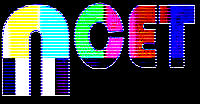"Stephen Beck and the Direct Video Synthesizer"
Excerpted from the article: "Pioneering Video Artist/Engineers & Electronic Imaging Technology:1968-78"
by Chris Meigh-Andrews, London, 2001
Around 1968, whilst experimenting with the sonic generation of oscilloscope
images, artist/engineer Stephen Beck began seeking more precise methods
of controlling light. His first attempt to build a device was
the "Number 0 Video Synthesizer," used in collaborative performances
with electronic musician Salvatore Martirano.
In 1970 Beck was invited to be Artist-in-Residence at the National Center for
Experiments in Television (NCET) in San Francisco. Whilst at NCET Beck
completed his "Direct Video Synthesizer" and used the new instrument to
produce a series of tapes called Electronic Notebooks. Intended as both
documentation of the technical research and works in their own right, these
tapes were made by artists and composers including Don Hallock, Bill Roarty,
Willard Rosenquist, Bill Gwin and Warner Jepson as well as by Beck himself.
The Direct Video Synthesizer, designed as a performance instrument, was
intended to be used to produce video images without a camera. Beck saw his
machine as an "electronic sculpting device" designed to generate four key
aspects of the video image- colour, form, motion and texture. In a subsequent
version, Beck extended the scope of the device to include circuits to generate
the elemental images of air, fire and water. Beck's stated concern was to open
up television as an expressive medium and to go beyond the manipulation of
the conventional camera image to produce non-objective imagery.
In "Image Processing and Video Synthesis", Beck discusses the various
approaches of American video artists to the construction and use of video
imaging tools, outlining and summarizing the instruments in use at the time-
(1975), identifying four distinct categories of electronic video instruments:
1) Camera Image Processing.
2) Direct Video Synthesis.
3) Scan Modulation/Rescan.
4) Non-VTR recordable.
In this survey of the range and
variety of electronic imaging instruments,
he explains attempts by artists to
exploit the inherent plasticity
of the medium to expand it beyond a strictly
photographic/realistic representational
aspect which characterizes the history of television in general.
Beck also identifies two tendencies in the designing and building of video
processing instruments by artist-engineers; the former is one in which the
images produced are a direct result of the circuitry and design of the
instrument, the latter takes place when an instrument has been developed in
order to produce a particular visual or psychological effect.
1. Camera Image Processors
This type of instrument is designed to modify the monochrome video image
from a black and white television camera. It usually includes a colouriser,
which adds chrominance (colour) signals to the video signal, keyers and
quantisers to separate luminance value levels in the signal in order to add
synthetic colour and/or to insert additional images into the original. Further
circuits may include modifiers that enable effects such as polarity inversion
and mixing via the superimposition of multiple image sources. This category
of instrument includes the Paik/Abe synthesizer, image processors used by
the Vasulkas, and Peter Donebauer's "Videokalos IMP" (1976).
2. Direct Video Synthesizers
Designed to operate primarily without a camera signal, these instruments
contain circuitry to generate a complete video signal including colour
generators to produce chrominance signals, form generators circuitry
designed to produce shapes, lines, planes and points, and motion modulators
to move them via electronic wave forms including curves, ramps, sines,
triangles and audio frequency wave patterns. These instruments also contain
texture amplifiers that produce "brush effects" such as shading and
chiaroscuro and textural effects such as grain. Instruments in this category
includes Stephen Beck's own "Direct Video Synthesizer" and the EMS
"Spectron" designed by Richard Monkhouse.
Beck also
designed and built the "Video Weaver" in 1975, inspired by the analogy
between weaving and the construction of the television image. The circuits for
Video Weaver were incorporated into his "Direct Video Synthesizer" and used
to produce a series of tapes called Video Weavings.
3. Scan Modulation/Rescan
In this process images are produced using a television camera rescanning an
oscilloscope or CRT screen. The display images are manipulated (squeezed,
stretched, rotated, etc.) using magnetic or electronic deflection modulation.
The manipulated images, rescanned by a second camera are then fed
through an image processor. This type of instrument was also used without an
input camera feed, the resultant images produced by manipulation of the
raster. Examples of this type of instrument include The Paik/Abe Synthesizer,
and the Rutt/Etra Scan Processor (1973).
4. Non-VTR Recordable
Beck included this category for completeness. This approach is basically a
'prepared' television set, to present a non-recordable distorted display, such
as Nam June Paik's Magnet TV (1965), but resultant images could be
recorded using rescanning methods. This category therefore also includes Bill
Hern's "Vidium Colourising Synthesizer" (1969) as used by Skip Sweeny in
his video feedback work - for example Illuminatin' Sweeny (1975). |

